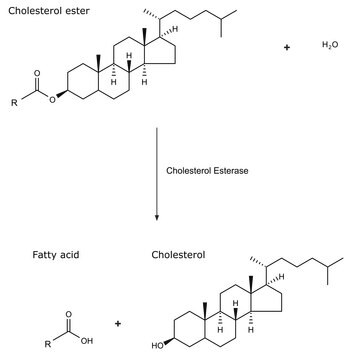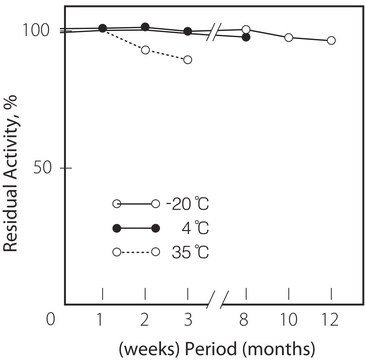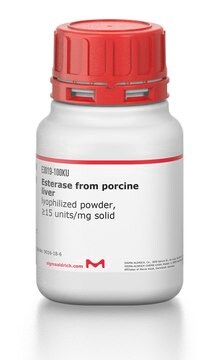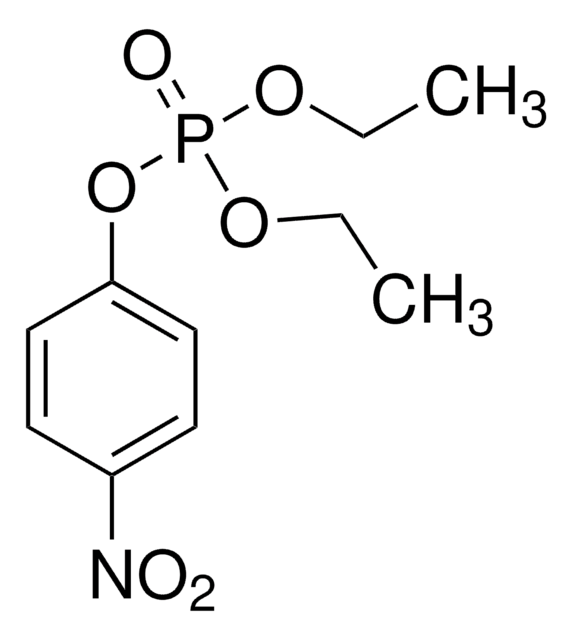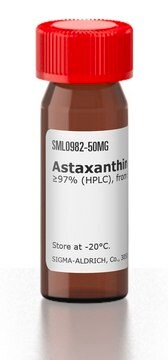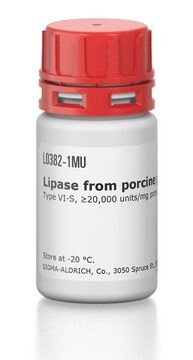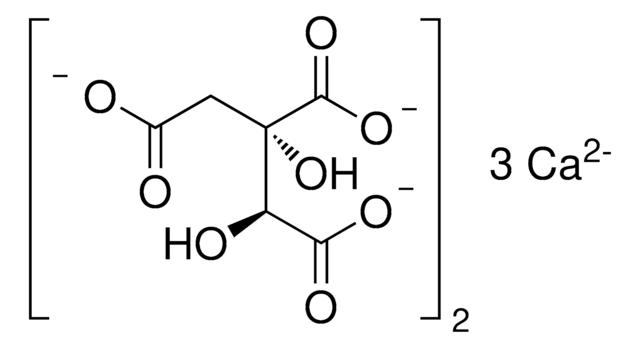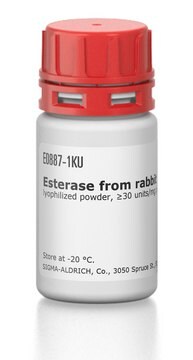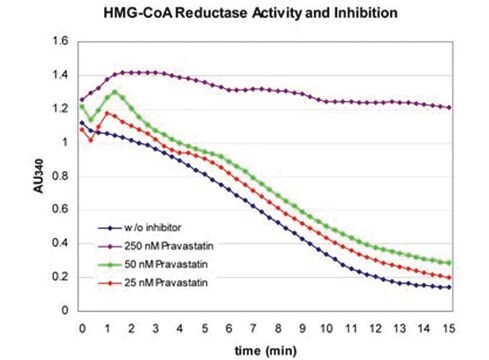26745
Cholesterol Esterase from porcine pancreas
lyophilized, powder, white, ~35 U/mg
Synonym(s):
bile salt-dependent lipase, bile salt-stimulated lipase, carboxyl ester lipase, nonspecific lipase, pancreatic lysophospholipase, Cholesterol Esterase from hog pancreas, Sterol-ester acylhydrolase
Sign Into View Organizational & Contract Pricing
All Photos(1)
About This Item
Recommended Products
biological source
Porcine pancreas
Quality Level
form
powder
quality
lyophilized
specific activity
~35 U/mg
mol wt
Mr ~440000
color
white
storage temp.
−20°C
Looking for similar products? Visit Product Comparison Guide
General description
Research area: Cell signaling
Pancreatic cholesterol esterase (CEase), also known as bile salt stimulated lipase, is a serine hydrolase belonging to the α/β hydrolase family of enzymes. They are released from the exocrine pancreas. Serine 194, histidine 435 and aspartate 320 represent the catalytic triad of the enzyme.
Pancreatic cholesterol esterase (CEase), also known as bile salt stimulated lipase, is a serine hydrolase belonging to the α/β hydrolase family of enzymes. They are released from the exocrine pancreas. Serine 194, histidine 435 and aspartate 320 represent the catalytic triad of the enzyme.
Application
Cholesterol Esterase from porcine pancreas has been used:
- in an in vitro simulated digestion model to improve the hydrolysis of carotenoid esters in the intestinal phase
- to analyze the bioavailability of phytosterol and cholesterol in the aqueous micellar phase of an in vitro simulated digestion model
- as a standard in enzyme activity assay
Biochem/physiol Actions
Cholesterol esterase (CEase), an enzyme having broad substrate specificity plays a key role in regulating the bile salt mediated hydrolysis of dietary cholesteryl esters. It also participates in the hydrolysis of triglycerides and phospholipids which are essential for normal cholesterol absorption. Cholesterol esterase hydrolysis helps in the determination of total cholesterol levels in the serum and plasma. Additionally, cholesterol esterase (CEase) along with phospholipase A2 is involved in the hydrolysis of lecithin to lysolecithin, forming intestinal micelles that deliver free cholesterol to enterocytes. Loss of enzyme function results in reduced intestinal absorption of dietary cholesteryl esters and prevents the formation of intestinal micelles, thereby failing to deliver cholesterol efficiently. Circulating cholesterol esterases, accumulated in atherosclerotic lesions are involved in triggering the proliferation of smooth muscle cells. Lastly, they are also selectively involved in the hydrolysis/condensation of carboxylic ester bonds.
Unit Definition
1 U corresponds to the amount of enzyme which liberates 1 μmol cholesterol per minute at pH 7.0 and 37°C (cholesterol acetate as substrate)
Other Notes
Sales restrictions may apply
Signal Word
Danger
Hazard Statements
Precautionary Statements
Hazard Classifications
Resp. Sens. 1
Storage Class Code
11 - Combustible Solids
WGK
WGK 1
Flash Point(F)
Not applicable
Flash Point(C)
Not applicable
Personal Protective Equipment
dust mask type N95 (US), Eyeshields, Gloves
Choose from one of the most recent versions:
Already Own This Product?
Find documentation for the products that you have recently purchased in the Document Library.
Customers Also Viewed
Baojian Li et al.
European journal of medicinal chemistry, 45(5), 1955-1963 (2010-02-13)
Due to the importance of pancreatic cholesterol esterase (CEase) as a potential target in atherosclerosis and for the development of hypocholesterolemic agents, there are increasing interests in designing and synthesizing CEase inhibitors. In the present study, we prepared forty-five isocoumarin
R.J. Kazlauskas
Journal of the American Chemical Society, 111, 4953-4953 (1989)
J. Siedel et al.
Methods of Enzymatic Analysis, 8, 139-139 (1985)
Ömer Şahin et al.
Journal of biomolecular structure & dynamics, 1-15 (2021-01-23)
In this work, Combining coumarin and thiazole with 3-tertiary butyl salicylaldehyde into in a single molecule, new Schiff base (CTS), and its metal complexes with palladium and platinum were synthesized and characterized by using well-known spectroscopic techniques such as 1H-NMR
Kevin R Shreder et al.
Bioorganic & medicinal chemistry letters, 22(17), 5748-5751 (2012-08-11)
KIAA1363 is a serine hydrolase whose activity has been shown to be positively associated with tumor cell invasiveness. Thus, inhibitors of KIAA1363 represent a novel targeted therapy approach towards cancer. AX11890 ((1-bromo-2-naphthyl) N,N-dimethylcarbamate) was identified as a KIAA1363 inhibitor with
Our team of scientists has experience in all areas of research including Life Science, Material Science, Chemical Synthesis, Chromatography, Analytical and many others.
Contact Technical Service

